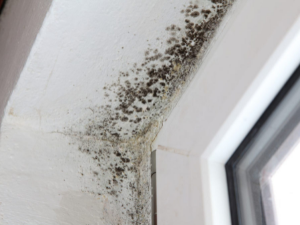
Mold and your health (symptoms of exposure)
Molds (sometimes spelled mould) is a fungi that grows in a colony as a network of microscopic tubular branches called hyphae. Visible fungal colonies are commonly called mold or sometimes mildew. Molds are found almost everywhere and are members of a large group of eukaryotic organisms. Molds are regularly found indoors and outdoors – in the air and on surfaces and materials, no indoor space is free of them. Molds play an important role in nature by decomposing matter back into natural elements – it is through this process which they derive their energy. Mold, and their spores, are found on living tissue outside the body (on the skin) and inside (such as the nose and lungs) where, with opportune conditions, they may grow. Jock itch (Tinea cruris) is a species of fungi.

Unlike bacteria (that are one-celled organisms) molds are multi-cellular and can sometimes be seen with the naked eye. Under a microscope, molds look like skinny mushrooms and many molds exhibit a body structure that consists of:
- root threads that invade the food or matter it lives on,
- a stalk rising above from the root, and
- spores that form at the ends of the stalks.
Molds grow best in warm, damp, and humid conditions, and they spread and reproduce by making and, when dry, releasing their spores in much the same way as blown dandelion seeds. Spores can survive in harsh environmental conditions that do not normally support mold growth. Attention is focused on mold growth indoors, however it is not the only dampness related microbial agent – mold growth is usually accompanied by bacterial growth.
There are thousands of known species of molds varying by geographic area, climate, season, and other factors. Some are beneficial and are used in commercial production of various foods and beverages as well as antibiotics and enzymes. Other species are opportunistic pathogens and can even produce toxins known as mycotoxins, and microbial volatile organic compounds (MVOCs) – for example the black mold Stachybotrys chartarum, which has been linked with sick building syndrome. It is by these byproduct toxins that recent discoveries have suggested molds connection to cancers and neurological problems, although the current state of some of this research is inconclusive and ongoing. A well known mold toxin, Aflatoxin1, is a particular focus of some of these studies and specific cancers are implicated include testicular, breast, stomach2 and liver cancers. The prevention of aflatoxin is one of the most challenging toxicology issues of present time.

Symptoms of mold exposure include:
- nasal stuffiness and/or sneezing
- eye irritation, itchy watery eyes
- headaches or migraines
- wheezing, coughing, respiratory irritation
- skin irritation
- inflammation
- tiredness and/or malaise
More severe reactions may occur with heavier exposed to large amounts of molds and symptoms may progress to include:
- fever
- shortness of breath
- infections (typically the lungs), bronchitis
Individuals with preexisting conditions such as asthma or pneumonitis, may find those conditions triggered and exacerbated.
References:
1Toxic mold aflatoxin found in Iowa and S.Dakota corn
http://www.reuters.com/article/2007/10/16/us-corn-aflatoxin-idUSN166858320071016
2Mayo Clinic – Factors that increase your risk of stomach cancer
http://www.mayoclinic.com/health/stomach-cancer/DS00301/DSECTION=risk-factors
